Pike Fishing in North America & the UK: Everything You Need to Know
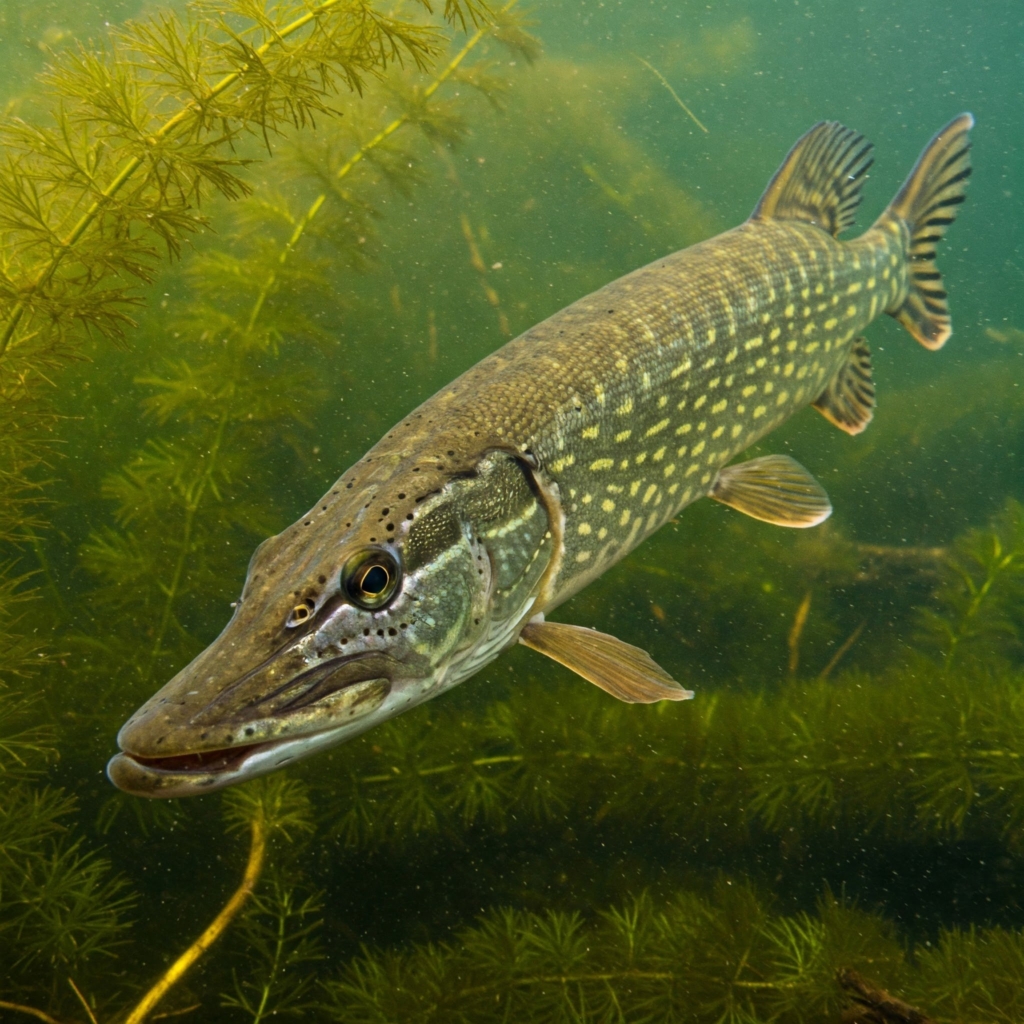
The pike. It’s a fish that sparks the imagination of anglers everywhere, a true apex predator in freshwater lakes and rivers. Known for its aggressive strikes, powerful runs, and the thrill of the chase, pike fishing is an experience like no other.
Picture this: You’re out on the water, rod in hand, casting your line with anticipation. Suddenly, there’s a jolt, your rod bends, and the fight is on! That’s the magic of pike fishing.
But landing a trophy pike isn’t just about luck. It takes skill, knowledge, and the right approach. That’s where we come in. This guide is your ultimate resource for everything pike fishing. We’ll cover:
- Understanding Pike Behavior: Learn how these predators think, where they hang out, and what triggers their strikes.
- Gear Up for Success: Discover the best rods, reels, lines, and lures for tackling pike in different conditions.
- Master the Techniques: From casting and retrieving to bait presentation and hook sets, we’ll break down the most effective pike fishing methods.
- Find the Hotspots: We’ll point you to some of the best pike fishing destinations in the US, Canada and UK, so you can plan your next adventure.
Whether you’re a seasoned angler looking to refine your skills or a beginner eager to land your first pike, this guide has something for you. Get ready to experience the thrill of pike fishing!
Tackling Pike: Gear Up for the Hunt
Pike rod
A good pike rod is the foundation for successful pike fishing. It should be sturdy yet sensitive enough to detect the subtle takes of a pike. Look for a rod with enough casting weight to handle larger pike lures with ease.
The ideal properties of the pike rod depend on the fishing method you’ll be using.
Pike Rods for Lure Fishing

Daiwa Prorex X Spin Pike Rod for Spin Fishing: 2.70 m long, two-piece rod with 40-100 g casting weight.
When lure fishing, an artificial lure is cast and retrieved, mimicking a fleeing fish. This method offers the advantage of covering large areas of water, increasing the chance of catching a pike. Good spinning rods for pike fishing have the following features:
- Adequate casting weight
- Fast action
- Two-piece or one-piece carbon fiber blank
- Length of 7 – 10 ft
Pike lures can be quite heavy, especially large crankbaits or swimbaits. With a rod with sufficient casting weight, you can easily cast these lures long distances, reaching the pike’s lairs further from the shore.
A common casting weight range is 1.4 – 3.5 oz, but there are also spinning rods suitable for fishing with even lighter or heavier lures.
A fast action means that the rod mainly bends in the upper third during the cast and the fight. This has several advantages when pike fishing:
- Better hookset: Pike have a hard mouth. With a fast rod, you can set the hook with more power and precision.
- More direct lure control: You can better feel what the lure is doing underwater and can guide it more precisely.
- More control in the fight: A fast rod gives you more control over the fish and helps you land it safely.
Two-piece rods are more convenient to transport than one-piece rods. They are also lighter and have a better action compared to telescopic rods. One-piece rods usually have the best action and are even more sensitive than multi-piece rods.
Carbon fiber is a light and robust material that is ideal for spinning rods. Carbon fiber rods allow for long days of fishing without fatigue.
The optimal length of your pike rod depends heavily on the conditions at the water:
7 – 8 ft:
Ideal for overgrown banks where you can cast and handle better with a shorter rod.
Also well suited for fishing from a boat, kayak or belly boat.
Gives you more control in the fight, especially in waters with obstacles.
9 – 10 ft:
The all-round length for most pike anglers.
Allows for longer casts from the shore, which is especially important on large lakes and rivers.
Offers a good balance between casting distance and control.
Over 10 ft:
Only necessary in exceptional cases, e.g. if you need extreme casting distances.
Can quickly become unwieldy when spin fishing.
Pike rods for lure fishing can also be used for bait fishing with dead baitfish without hesitation.
Pike Rod for Bait Fishing with Dead Baitfish
When bait fishing with dead baitfish, the weight of the pike rod is of secondary importance, as the rod is placed on a rod holder after casting. A good pike rod for bait fishing should have at least these features:
- Sufficient casting weight
- Telescopic rod
- Medium-fast action
- Length of 9 – 14 ft
- Composite material made of fiberglass and carbon fiber
Pike rigs with baitfish can be quite heavy. So your rod needs enough power to cast these rigs to the desired distance. Pay attention to a casting weight that matches the baitfish you want to use.
Telescopic rods are very popular for bait fishing because they are compact and easy to transport. Ideal if you travel a lot and want to stow your equipment flexibly. They are also cheaper than one-piece or multi-piece rods.
A medium-fast action is often the best choice for bait fishing for pike. It allows for long casts and cushions the pike’s flights well. This minimizes the risk of dropouts.
Compared to lure fishing, a fast action of the rod is not necessary, as eating a baitfish usually takes longer than a short and fast attack on a lure.
The optimal length of your pike rod for bait fishing depends on the conditions at the water.
9 – 10 ft: A good all-round length that is suitable for many situations.
11 – 12 ft: Ideal for larger waters where you need longer casts.
13 – 14 ft: Is used when you have to cast very far or fish on heavily overgrown banks.
Composite material combines the advantages of both components: fiberglass makes the rod robust and resistant, while carbon fiber provides lightness and sensitivity. So you have a rod that can withstand the stresses of pike fishing and is comfortable to handle at the same time.
Many feeder rods for coarse fishing are also made of composite material and you can use these rods just as well for bait fishing for pike if the casting weight fits.
Rod and Reel for Fly Fishing for Pike
For fly fishing for pike, it is best to use a rod and reel of class #8 or #9. Since this combination can be somewhat heavy, a rod with a maximum length of 9 ft is recommended to ensure fatigue-free fishing.
Pike fishing reel
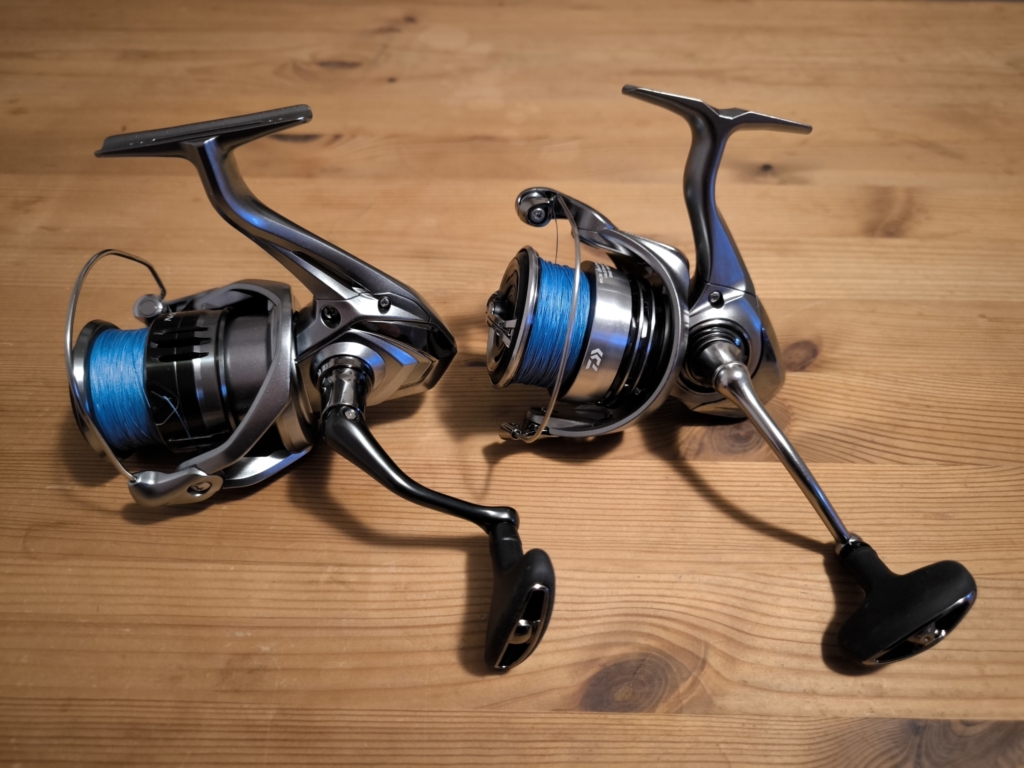
Two size 4000 spinning reels for pike fishing. Left: Shimano Nasci 4000XG. Right: Daiwa Exceler LT4000D-C.
For pike fishing, we recommend spinning reels with the following features:
- Line capacity of at least 110 yards of 20 lb test braided line
- Gear ratio of 5.0:1 or higher
- At least 3 ball bearings
- Smooth drag with at least 11 lb of drag power
- 4000 size
A sufficient line capacity is important for pike fishing to be able to cast far and to have enough line reserves to be able to safely drill the fish.
A gear ratio of 5.0:1 or higher allows you to guide the lure dynamically when spin fishing and to reel in your rigs quickly.
From a number of 3 ball bearings, spinning reels have a particularly smooth run, which makes hours of spin fishing much more pleasant.
A smooth drag with sufficient drag power allows you to control the fish well during the fight and bring it ashore. Some 4000 reel models already have high drag forces of 20-26 lb and thus offer even additional reserves if a catfish bites the pike lure.
The 4000 sizes of most spinning reels have a sufficient line capacity for pike fishing. With some reels, the spool is not very deep and not much line fits on the reel. In this case, you can also take a 5000 model as a precaution.
Pike fishing line
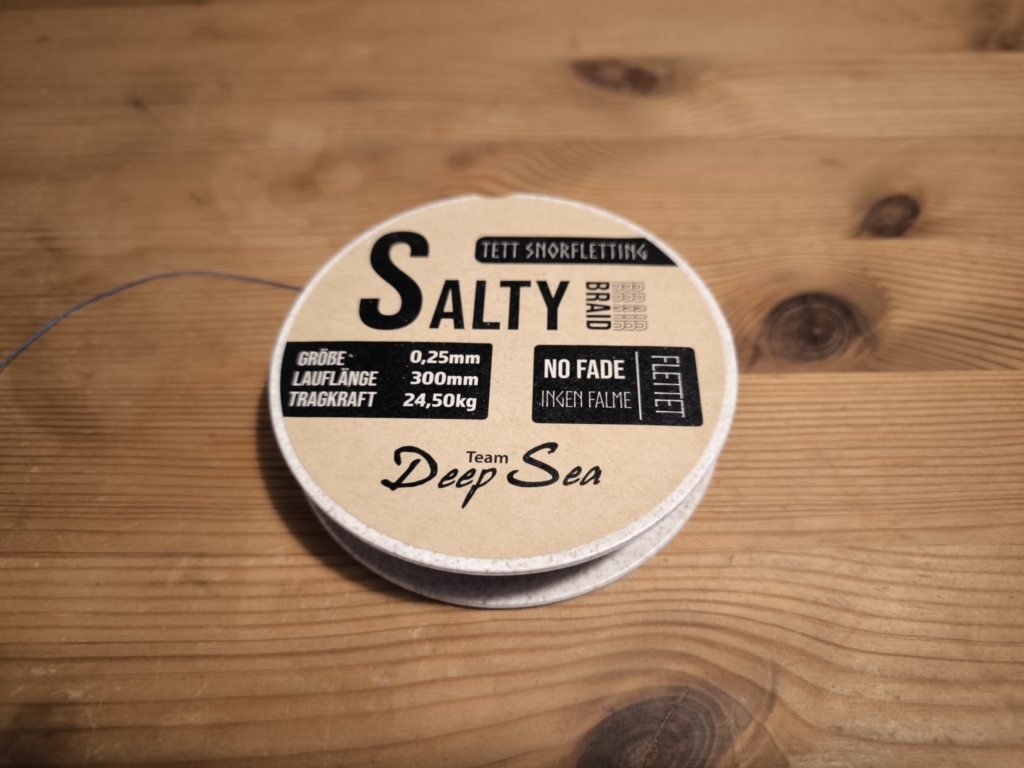
Braided fishing line with 54lb breaking strength.
Most pike anglers fish with lures and trust braided line. But the use of classic monofilament line is still widespread and can sometimes even be better. Here are the properties of good fishing lines for pike fishing:
- Braided line with a strength of at least 20 lb test
- Monofilament, low-stretch line with a strength of at least 20 lb test
- Coated, braided line with a strength of at least 20 lb test
Braided lines offer the advantage that they have no stretch. This makes it particularly easy to feel the bite when spin fishing for pike and to set the hook better. However, they can be damaged by abrasion in waters with many stones.
If you are not specifically fishing for particularly large pike, a braided line with a strength of 20 lb test is usually the right choice.
In waters with many stones and a high risk of snagging, a monofilament line can be the better choice because it is more abrasion-resistant. When using a monofilament line, one with low stretch should be chosen.
Coated braided lines combine the best of both worlds. They are abrasion-resistant like a monofilament line and have the high load capacity of a braided line. As with the uncoated braided lines, the strength of 20 lb test is sufficient in most cases.
Additional gear you’ll need for pike fishing
Of course, a good rod, reel, and line are the foundation for any pike fishing setup. But to be fully prepared and successful, you’ll need a few other key pieces of equipment:
- Fishing License: This is your official permission to fish. Requirements vary by state, so check your local regulations.
- Knife: A sharp knife is a must-have for various tasks, from cutting line to preparing bait.
- Hook Remover: Pike have sharp teeth and strong jaws. A long hook remover (pliers or a specialized tool) is crucial for safely and efficiently removing hooks, especially if you plan to release the fish.
- Gag (Mouth Spreader): This tool helps to keep the pike’s mouth open while you’re removing a hook, particularly useful for practicing catch and release.
- Landing Net: A sturdy net is essential for safely bringing your catch aboard or onto the shore. Choose one with a large enough hoop and a deep, knotless mesh to protect the fish.
- Lures or Baits: Select your preferred lures or dead baits. This will depend on the type of pike fishing you’re doing.
- Wire Leader: A wire leader is absolutely essential when fishing for pike. Their sharp teeth can easily slice through regular fishing line.
- Terminal Tackle and Extras: You’ll need swivels, snaps, leaders, and other components to rig your lines and lures. It’s always a good idea to have a selection of extra tackle on hand.
Choosing the Right Lures for Pike Fishing
The selection of pike fishing lures can be overwhelming. What lure works best depends on various factors, such as the time of year, the body of water, and your fishing technique. Here’s an overview of the most common pike lures:
Artificial Lures
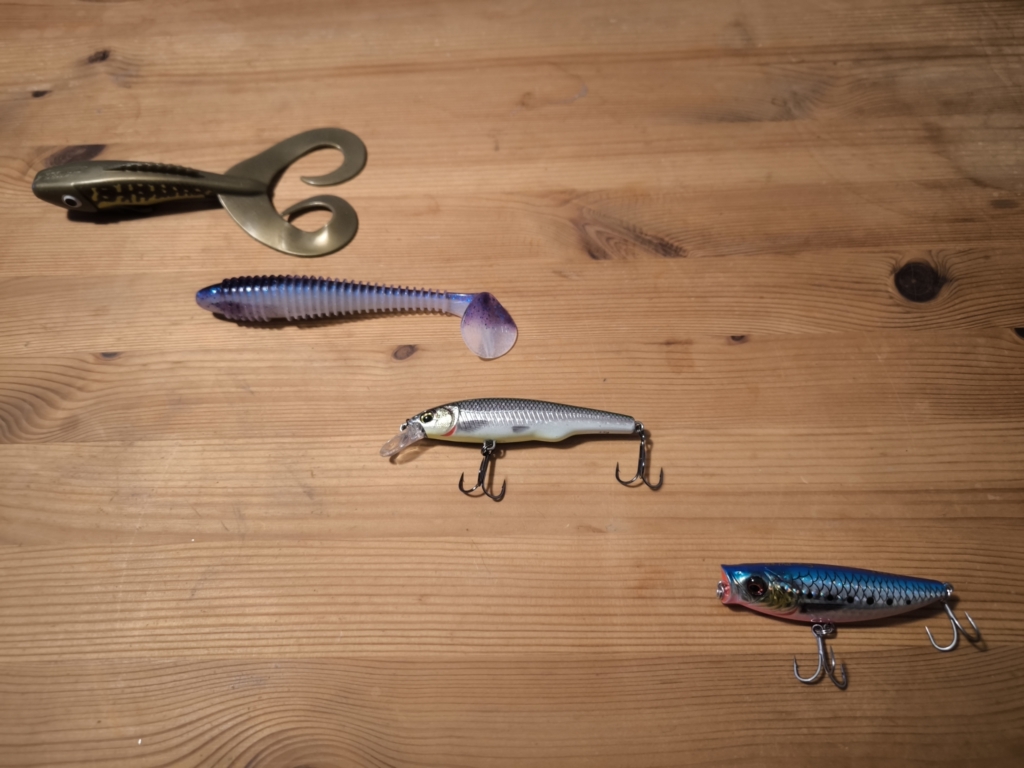
From left to right: Double-tailed swimbait in pike design, swimbait, crankbait, and popper.
- Spoons: The spoon is a classic pike lure that wobbles back and forth as it is retrieved, imitating a fleeing, injured baitfish. It looks like a metal spoon with a treble hook attached. Due to their compact size and high weight, spoons can be cast very far.
- Soft Plastics: Soft plastics are one of the most popular lures for pike fishing. They are available in all imaginable sizes and colors, and they are inexpensive.
- Crankbaits: Crankbaits are hard lures (hardbaits) that resemble a fish in appearance. When retrieved, they mimic the typical swimming movement of a fish. Crankbaits are usually made of wood, plastic, or metal, and they are available in floating, suspending, and sinking variants. The diving depth of a crankbait is mainly determined by the angle of the diving lip at the front. Deep-diving crankbaits have a diving lip that points straight forward at a flat angle. Shallow-running crankbaits have a diving lip that points downwards at a larger angle.
- Topwater Lures: Topwater lures are an umbrella term for all artificial lures that can be fished on the surface of the water or just below it. These include poppers, crankbaits, jerkbaits, and also unweighted soft plastics. Topwater lures can be very catchy and advantageous when pike are in very shallow water areas, especially in the warmer seasons. They are also a good lure for fishing waters that are heavily overgrown with plants from the bottom to the middle of the water column.
- Spinners: A spinner is an artificial lure used in fishing to attract fish. It consists of a metal blade that rotates around an axis when it is pulled through the water. The rotational movement of the blade creates vibrations and light reflections that attract predatory fish such as pike, perch, and trout. Spinners are available in various sizes, shapes, and colors to appeal to different species of fish and fishing conditions. They are versatile lures that can be used in both still and flowing waters.
- Spinnerbaits: Spinnerbaits are a type of fishing lure that is particularly popular with anglers who target predatory fish such as pike, perch, and zander. They are characterized by their unique design, which combines a wire arm with a lead head, a hook, and one or more spinner blades.
Natural Baits
Dead Baitfish: Dead baitfish are also a very popular bait for pike fishing. They are offered on the bottom or with a float and offer the advantage that they can attract pike from greater distances due to their scent.
In addition to perch, roach, and chub, particularly fatty fish such as mackerel, herring, and sardines are also a very good bait for pike fishing. Due to their fat content, these fish distribute a scent trail in the water that reaches particularly far.
What is the best lure size for pike fishing?
Pike can also eat fish that are half as long as they are themselves. As a standard size for pike fishing, we recommend soft plastics with a length of at least 6 inch. A dead baitfish should also not be smaller than this.
For spoons and hardbaits, models from 1 oz in weight are particularly suitable for catching pike. The larger the lure, the larger the pike that bite on it will be on average. As a rule of thumb, smaller lures lead to more bites and larger lures to larger fish (with less frequent bites).
For example, if you catch a 1 ft long, undersized pike while fishing with a 6 inch long soft plastic, it is definitely time to use a larger lure.
What is the best lure color for pike fishing?
The best lure color depends on the weather, water conditions, and other factors on the water. In sunny weather and clear water, lures with more natural and inconspicuous colors often catch better.
In cloudy weather and murky water, lures in conspicuous colors are more visible to pike underwater and often bring more bites.
In some waters, certain lure colors have been used so often that the pike have learned from it and no longer bite on this color, although you would have achieved good catches with this lure color elsewhere under the same conditions.
In such overfished waters, it also helps to ask experienced, local anglers about the catchy lure colors.
A perennial favorite in many waters are often artificial lures that, with their colors, faithfully reproduce a roach, a pike, or a perch. Pike are cannibalistic and also eat smaller pike.
This peculiarity can be used to your advantage by using a soft plastic or wobbler with a beautiful pike design.
Pike Fishing Methods and Rigs
There are several ways to fish for pike. Here are some of the most common methods:
Spin fishing: This is the most active method, in which an artificial lure is retrieved through the water.
- Main Line: 100-150 yards of braided line with a strength of 20-30 lb test, or monofilament line with a strength of 20-30 lb test.
- Leader: A 15-25 lb test wire leader to prevent bite-offs from pike’s sharp teeth.
- Lure: Your choice of pike lure
The classic rig for pike spinning is very simple. The wire leader is tied to the main line. At the end of the wire leader, there is a snap swivel to which the lure is attached.
Still Fishing for Pike: Setting the Bait and Waiting for the Strike
With still fishing, you present a bait (usually a dead baitfish) in a specific location on the bottom and wait for the pike to find it.
- Main Line: 100-150 yards of braided line with a strength of 20-30 lb test, or monofilament line with a strength of 20-30 lb test.
- Weight: A 1-2 oz weight (or heavier, depending on current and depth) to hold the bait on the bottom.
- Bead: A bead to prevent the weight from damaging the knot.
- Leader with two treble hooks: A 15-25 lb test wire leader to prevent bite-offs from pike’s sharp teeth.
- Baitfish: Your choice of dead baitfish
- Scent Attractant (optional): A few drops of fish oil or scent attractant to enhance the bait’s appeal.
In bottom fishing, a weight is added to the main line to keep the baitfish on the bottom. A bead is placed directly below the weight to protect the knot from damage during casting. The baitfish is attached to the wire leader with two treble hooks.
For a secure hold, one treble hook can be attached to the mouth and the other to the side of the baitfish. A few drops of fish oil in the baitfish’s mouth can further enhance its scent.
Float fishing for pike: A variation of still fishing where the baitfish is presented with a float.
- Main line: 100-150 yards of braided line with a strength of 20-30 lb test, or monofilament line with a strength of 30-40 lb test.
- Bobber stop: A bobber stop is used to set the depth of the float.
- Float: A float with a buoyancy of at least 1/2 oz is used to suspend the baitfish.
- Split shot: Split shot weights are used to balance the float and ensure that it sits upright in the water.
- Leader with two treble hooks: A 15-25 lb test wire leader is used to prevent the pike’s sharp teeth from cutting the line.
- Baitfish: A dead or live baitfish is used as bait.
For pike float fishing, start by threading a bobber stop onto the main line, followed by the float. Then, tie the main line to the wire leader. Attach enough split shot weights to the main line above the leader swivel to ensure the float sits upright after casting.
To keep the baitfish positioned “upright” in the water, it’s best to attach the top treble hook to the upper back area. Secure the second treble hook to the lower belly.
As with other dead bait rigs, a few drops of fish oil in the baitfish’s mouth can help attract pike from a greater distance.
Fly Fishing for Pike: An Elegant and Challenging Pursuit
Fly fishing for pike is a unique and rewarding experience. It combines the artistry of fly casting with the thrill of targeting a powerful predator. While it requires specialized tackle and techniques, the payoff is well worth the effort.
- Main line: #8 or #9 intermediate sinking tip line
- Leader: 4-5 feet of 40 lb test monofilament
- Wire leader: 20-30 lb test
- Fly: Streamer (large, brightly colored patterns that imitate baitfish)
Attach a 4-5 foot section of 20 lb test monofilament leader to the intermediate sinking tip line using a loop-to-loop knot. Then, tie the monofilament leader to the wire leader. At the end of the wire leader, attach a streamer that imitates a small fish.
The intermediate sinking tip line offers the advantage that the streamer does not need to be weighted separately. Nowadays, there are also many fly lines available that have been specially developed for pike fishing.
Pike Fishing: Prime Times and Locations
Knowing when and where to find pike is key to a successful fishing trip. Here’s a breakdown of the best times to fish for pike and the types of locations they prefer:
Prime Fishing Times
Early Morning and Late Evening: These are generally the most productive times for pike fishing. They tend to be more active during these cooler periods.
Midday: While less consistent, pike can still be caught during midday, especially on overcast days or in stained water.
Where to Find Pike
Pike are ambush predators, so they tend to hang out in areas with plenty of cover and access to food sources. Here are some of the best places to look for them:
- Weed Edges: The edges of weed beds provide excellent ambush points for pike. They can hide in the weeds and dart out to attack unsuspecting prey.
- Woody Cover: Sunken logs, brush piles, and other woody debris offer similar cover to weed beds. Pike will often position themselves near these structures, waiting for baitfish to swim by.
- Drop-offs: Areas where the water depth suddenly changes can be productive pike fishing spots. These drop-offs can be along shorelines, channels, or points.
- Points: Points of land that extend into a lake or river can be great places to find pike. These areas often have current and attract baitfish, making them prime hunting grounds.
- Inlets and Outlets: Areas where water flows into or out of a lake or river can also hold pike. These areas often have current and attract baitfish, making them prime hunting grounds.
General Tips for Finding Pike
Look for Structure: Pike prefer areas with some type of structure, whether it’s weeds, wood, rocks, or drop-offs.
Follow the Food: Pike are predators, so they’ll be where the baitfish are. If you see schools of baitfish, there’s a good chance pike are nearby.
Consider the Season: Pike’s behavior and location can change throughout the year. In warmer months, they may move to deeper water or seek out cooler areas with shade.
Don’t Be Afraid to Explore: Sometimes the best way to find pike is to simply get out on the water and explore different areas.
By understanding pike’s preferred habitats and feeding patterns, you can increase your chances of finding and catching these exciting fish!
Pike Fishing by Season: Adjust Your Approach for Success
Pike fishing can be a year-round pursuit, but their behavior and location change with the seasons. Adjusting your tactics and presentations is key to consistently catching pike. Here’s a seasonal guide to help you maximize your success:
Spring (Post-Spawn)
- Location: Pike will be concentrated in shallow areas near spawning grounds. Look for weedy areas, back bays, and slow-moving tributaries.
- Lures: Pike are hungry after spawning, so they’ll be aggressive and willing to chase a variety of lures. Try larger lures like swimbaits, crankbaits, and spinnerbaits.
- Presentation: Use a fast retrieve to cover water and trigger reaction strikes.
Summer
- Location: As water temperatures rise, pike may move to deeper water or seek out cooler areas with shade. Look for them around weed edges, drop-offs, and areas with current.
- Lures: Pike can be more sluggish in the summer, so try using slower-moving lures like soft plastics, jigs, and crankbaits. Topwater lures can also be effective when pike are in shallow water or near the surface.
- Presentation: Vary your retrieve speed and presentation to find what the pike are responding to.
Fall
- Location: Fall is often considered the best time of year for pike fishing. They’re actively feeding to prepare for winter and can be found in a variety of locations. Look for them around weed beds, drop-offs, and areas with current.
- Lures: Pike are aggressive in the fall and will readily take a variety of lures. Larger lures like swimbaits, crankbaits, and spinnerbaits are good choices.
- Presentation: Use a moderate to fast retrieve to cover water and trigger strikes.
Winter
- Location: Pike tend to be less active in the winter and often school up in deeper water. Look for them in areas with structure, such as drop-offs, sunken timber, and weed edges.
- Lures: Use slow-moving lures like jigs, soft plastics, and dead baitfish.
- Presentation: Fish your lures slowly and deliberately, keeping them close to the bottom.
Top Locations for Pike Fishing in the USA, Canada, and UK
USA
1. Lake Mille Lacs, Minnesota: Known for its trophy-sized pike, this lake is a favorite among anglers seeking a challenging catch.
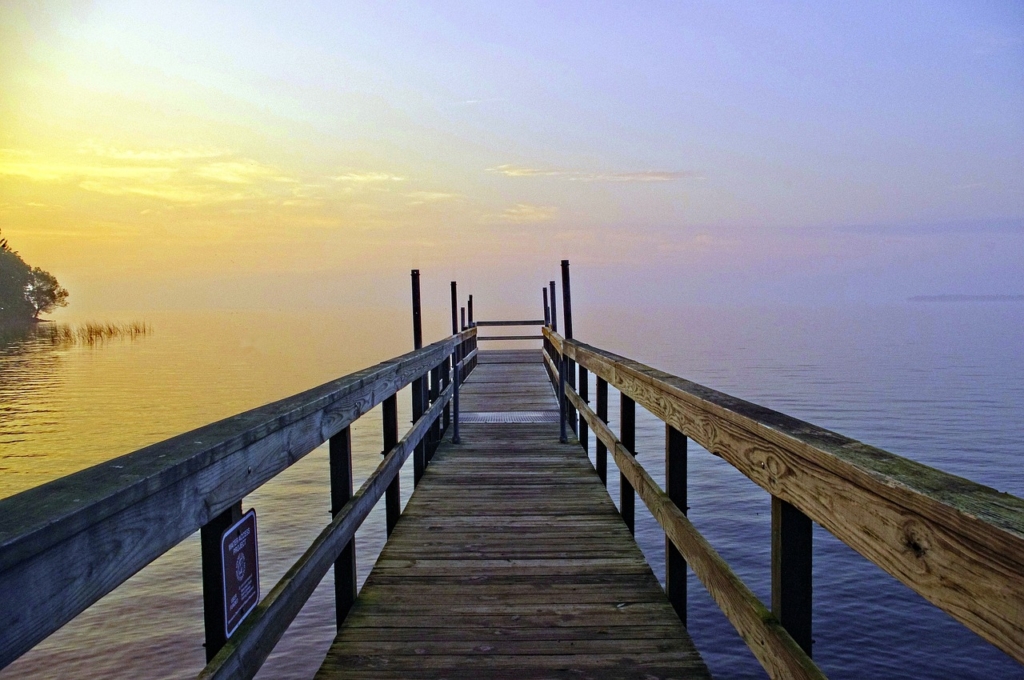
2. Lake of the Woods, Minnesota: With its vast expanse and diverse structure, this lake offers excellent pike fishing opportunities throughout the year.
3. Green Bay, Wisconsin: This bay is home to a healthy population of pike, and its shallow waters make it ideal for early-season fishing.
4. Lake Champlain, Vermont: This large lake boasts a diverse fishery, including a strong population of pike that can be caught using a variety of techniques.
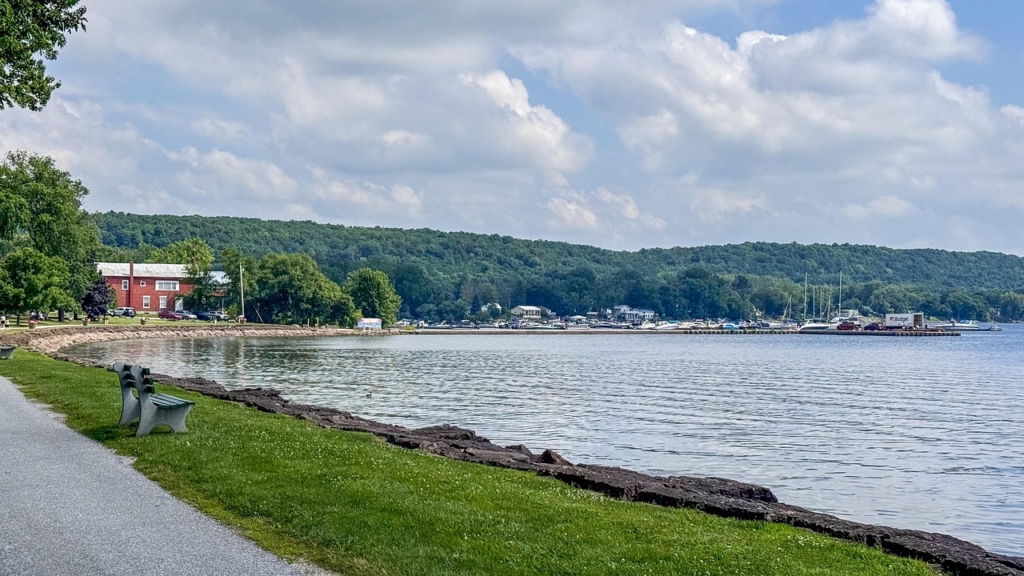
5. Sacandaga Reservoir, New York: This reservoir is known for its clear waters and abundant pike population, making it a popular destination for anglers of all skill levels.
6. Leech Lake, Minnesota: Another Minnesota gem, Leech Lake is known for its large pike and muskie population.
7. Rainy Lake, Minnesota: This border lake offers excellent pike fishing, with opportunities to catch fish in both the US and Canadian sections.
8. Lake Winnibigoshish, Minnesota: Known to locals as “Lake Winnie”, this lake is another excellent choice for trophy pike fishing.
9. Upper Red Lake, Minnesota: This lake is known for its clear waters and abundant pike population, making it a popular destination for anglers of all skill levels.
10. Lake Francis Case, South Dakota: This large reservoir offers excellent pike fishing, with opportunities to catch fish throughout the year.
Canada
1. Great Slave Lake, Northwest Territories: This massive lake is home to some of the largest pike in the world, with fish exceeding 50 pounds being caught regularly.
2. Lake Athabasca, Saskatchewan: This remote lake is known for its pristine waters and incredible pike fishing, with opportunities to catch fish of a lifetime.
3. Lac La Ronge, Saskatchewan: This lake offers a variety of pike fishing opportunities, from shallow bays to deepwater reefs.
4. Eagle Lake, Ontario: This lake is known for its healthy pike population and beautiful scenery, making it a popular destination for anglers seeking a wilderness experience.
5. Lake Nipissing, Ontario: This lake is home to a diverse fishery, including a strong population of pike that can be caught using a variety of techniques.
6. Wollaston Lake, Saskatchewan: This remote lake is known for its incredible pike fishing, with opportunities to catch fish over 40 pounds.
7. Reindeer Lake, Saskatchewan: Straddling the border between Saskatchewan and Manitoba, this lake offers excellent pike fishing in a remote wilderness setting.
8. Lake Manitoba, Manitoba: This large lake is home to a healthy population of pike, and its diverse structure makes it a popular destination for anglers of all skill levels.
9. Lake Simcoe, Ontario: This lake is located close to Toronto and offers excellent pike fishing, with opportunities to catch fish throughout the year.
10. Ottawa River, Ontario/Quebec: This large river system is home to a healthy population of pike, and its diverse structure makes it a popular destination for anglers of all skill levels.

UK
1. Loch Lomond, Scotland: This stunning loch is home to a healthy population of pike, and its scenic beauty makes it a joy to fish.
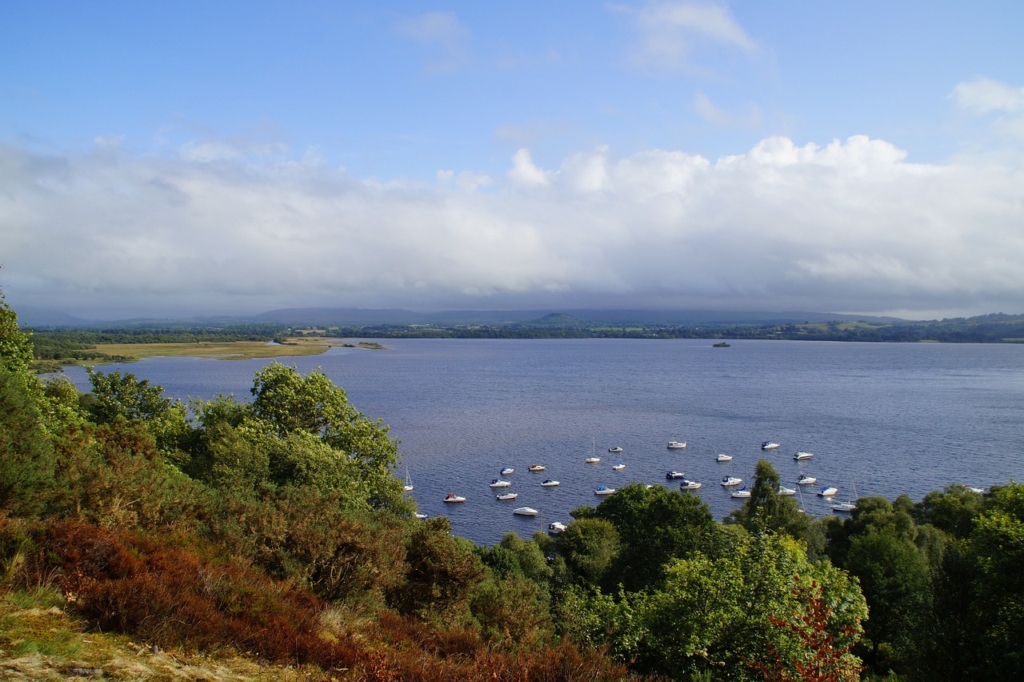
2. Loch Ness, Scotland: While famous for its elusive monster, Loch Ness also offers excellent pike fishing, with the chance to catch a fish of a lifetime.
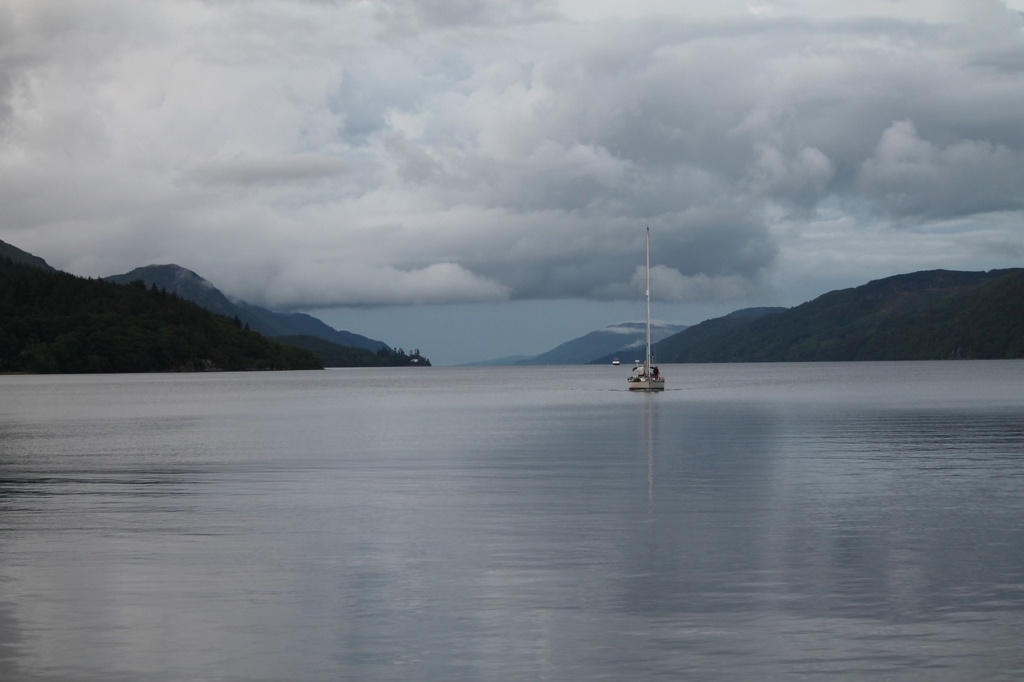
3. The Fens, England: This network of waterways is home to a diverse fishery, including a strong population of pike that can be caught using a variety of techniques.
4. Grafham Water, England: This large reservoir is known for its clear waters and abundant pike population, making it a popular destination for anglers of all skill levels.
5. River Thame, England: The River Thame is a tributary of the River Thames and offers some excellent pike fishing, especially in the winter months.
6. Lough Neagh, Northern Ireland: This large lough is home to a healthy population of pike, and its diverse structure makes it a popular destination for anglers of all skill levels.
7. River Shannon, Ireland: This large river system is home to a healthy population of pike, and its diverse structure makes it a popular destination for anglers of all skill levels.
8. Llyn Tegid (Bala Lake), Wales: This large lake is home to a healthy population of pike, and its scenic beauty makes it a joy to fish.
9. River Wensum, England: This river is known for its healthy pike population and beautiful scenery, making it a popular destination for anglers seeking a peaceful fishing experience.
10. Rutland Water, England: This large reservoir is known for its clear waters and abundant pike population, making it a popular destination for anglers of all skill levels.
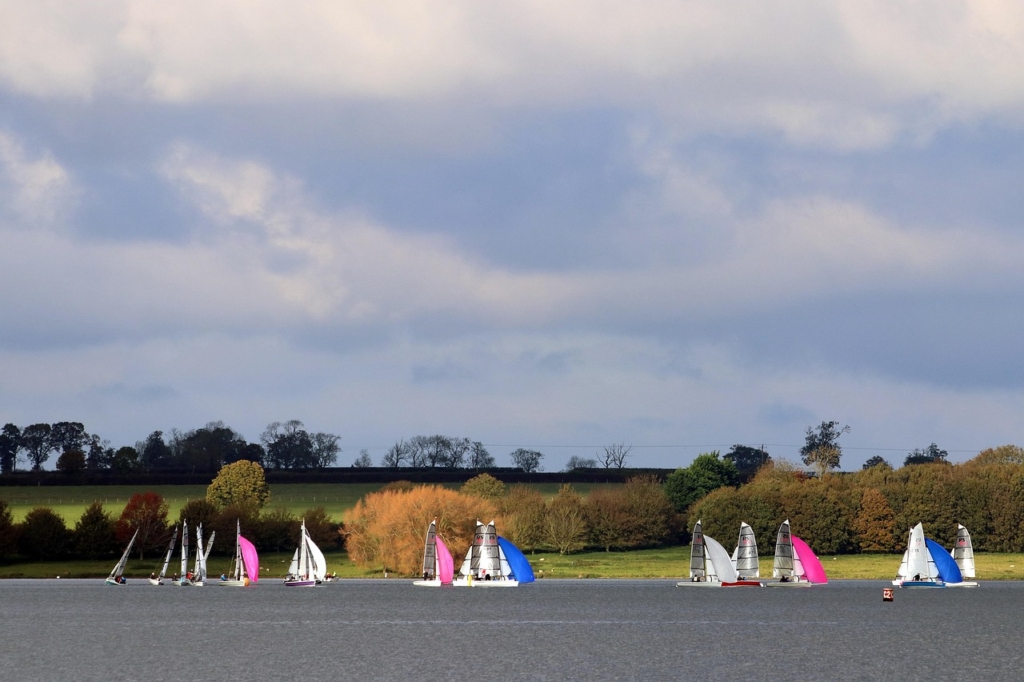
- Own experience
- Pictures: Pixabay.com